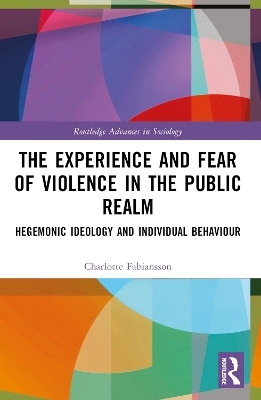
The Experience and Fear of Violence in the Public Realm
Routledge (Verlag)
978-1-032-47375-8 (ISBN)
This book explores violent and discriminatory values and beliefs and their interconnectedness between societal echelons. Violence has a foundation and a context. It comes from somewhere and is directed at someone or something, and it has an ambience established through generations of social, cultural, political, financial and religious strategies. It fashions nation-states’ hegemonic ideology and frames individual behaviours and attitudes, thus creating a milieu that enables the normalisation of violence. The focus is on violence-infused behaviours and actions in the public realm, a multifunctional environment for social and cultural activities, as well as a workplace, entertainment and transport hub. It is a public setting, sometimes demanding onerous deftness of individuals to stay safe. Attitudes, values and beliefs around violence, harassment and discrimination in the public realm frequently occur openly without anyone noticing that a crime has been committed, including by close bystanders. An audience steeped in societal hegemonic social and cultural patriarchal ideology might be oblivious to harassing or discriminative behaviours and attitudes against females, minority genders and ethnic minority groups. The habitual nature and normalisation of these invisible crimes make them easy to dismiss. Violence materialises on all societal levels: the hegemonic structural (macro) level, consisting of the society’s dominating political, financial, social, cultural and religious leaders, educational and community institutions (meso) level and the individual-agency (micro) level, hence the nationstate’s populace. Societal order is underpinned by structural, systemic and symbolic violence, all integrated into contemporary society’s cultural and social fabric, thus inconspicuous social norms as ingrained through internalisation. The book is written from a sociological perspective and within the risk society discourse, where the risk of violence in the public domain is omnipresent. Discourses of Arendt, Bauman, Bourdieu, Marx, Foucault, Galtung and Beck and present-day analysis underpin the discussions. The agency and political leadership research emphatically show that violence and discrimination are normalised and ingrained in the contemporary milieu.
Charlotte Fabiansson has a PhD in Sociology, is an Associate Professor and Adjunct Fellow at the College of Arts & Education, Victoria University, Melbourne, Australia. She is the author of Belonging and Social Identity among Young People in Western Sydney, Australia, after the Cronulla Riots, Journal of International Migration and Integration, 2018, 19, (2): 351-366; Pathways to Excessive Gambling: A Societal Perspective on Youth and Adult Gambling Pursuits (Ashgate Publishing Group, UK, 2010). She is the co-author of Food & the Risk Society: The Power of Risk Perception (Routledge, UK, 2016).
1 INTRODUCTION. 2 THEORETICAL FRAMEWORK AND LITERATURE REVIEW. 3 STRUCTURAL- AND AGENCY-LEVEL VIOLENCE, HARASSMENT AND DISCRIMINATION. 4 AGENCY-LEVEL VIOLENCE, HARASSMENT AND DISCRIMINATION. 5 FIRST NATION PEOPLES AND PEOPLE OF COLOUR. 6 INTERCONNECTEDNESS BETWEEN STRUCTURAL AND AGENCY LEVELS’ BELIEFS AND VALUES . 7 CONCLUDING COMMENTS
| Erscheinungsdatum | 05.08.2023 |
|---|---|
| Reihe/Serie | Routledge Advances in Sociology |
| Zusatzinfo | 16 Line drawings, black and white; 16 Illustrations, black and white |
| Verlagsort | London |
| Sprache | englisch |
| Maße | 156 x 234 mm |
| Gewicht | 467 g |
| Themenwelt | Sachbuch/Ratgeber ► Gesundheit / Leben / Psychologie |
| Sozialwissenschaften ► Ethnologie | |
| Sozialwissenschaften ► Pädagogik ► Sozialpädagogik | |
| Sozialwissenschaften ► Soziologie ► Allgemeines / Lexika | |
| Sozialwissenschaften ► Soziologie ► Spezielle Soziologien | |
| ISBN-10 | 1-032-47375-4 / 1032473754 |
| ISBN-13 | 978-1-032-47375-8 / 9781032473758 |
| Zustand | Neuware |
| Haben Sie eine Frage zum Produkt? |
aus dem Bereich


